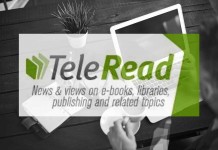Earlier today, Paul Hoover wrote a comment to David’s post about Origami:
I work on the Microsoft team responsible for Origami as a product designer. Do you have any feedback on the device shown from an e-book perspective?
Here’s what I say to Paul:
Microsoft Reader is extremely well designed — improving on it doesn’t mean changing its design.
But if MS Reader could open text or html files directly, without requiring conversion, that would be a win.
If Flash or SVG graphics could be displayed, including those with motion and with interactivity, that would be a win. If audio files could be played (not just music, but pronunciation of foreign-language terms or of names), that would be a win.
If the text could be read aloud, that would be a win.
If I could choose my own fonts, change the type size in single-pixel increments, change reading orientation from portrait to landscape, and set alignment/size/font by element (title, paragraph, footnote, etc.) — the way I can in FBReader on the Nokia 770 — that would be a win.
If other e-readers could run on an Origami-class machine, that would be a win. (Shouldn’t be a problem with XP.)
If clicking on a link would bring up another text, open to the relevant passage, that would be a win.
If clicking on a URI would open a window to display a website, that would be a win. (Internal window? Browser window? Whatever you can manage.)
If annotations and highlighting could be exported and opened in some other e-reader (on another machine? in a different program entirely? Whatever you can manage.), that would be a win. If annotations could be shared on the web, downloaded and combined with my own (think: book group), that would be a win.
If plug-ins that extended MS Reader could be allowed, to add the features Microsoft doesn’t want to, that would be a win.
If other e-book formats could be read within MS Reader — at least the non-proprietary and non-DRMed versions — that would be a win.
If XML in any vocabulary — DocBook, TEI-lite, my work documents valid against my company DTD — could be displayed with CSS in MS Reader, that would be a win.
If complicated HTML tables could be displayed in MS Reader, that would be a win. If MathML could be displayed, that would be a win.
These are the kinds of things that would make the Origami a really desirable e-reader, Paul. In my opinion.
Added later: Most of my suggestions might seem oriented more towards Microsoft’s e-reading program than the Origami hardware and hence out-of-bounds for Paul. But for some of these it’s hard to separate one from the other, I think — is Flash the responsibility of Reader (as a plug-in, sure) or the device (it is if OS compatability or CPU speed prevent it)? What about page rotation/orientation — could be handled in either. To my way of thinking, simply providing a lightweight, affordable, page-size device is the biggest boon Microsoft could give the e-book industry. And providing it with an enhanced MS Reader and not a dated relic from the last e-book wave is the best way to showcase Origami.
Of course, as Alexander R. Pruss noted, the buttons to advance from page to page need to be easily reached with either hand. With the RocketeBook, I used to read for a while holding the device with one hand, then flip the orientation and then hold it with the other hand. So the buttons need to be conveniently and versatile (programmable by orientation?). And the scroll wheel on my old HP Jornada 540 worked wonderfully well to advance pages.
Telereaders are encouraged to post their own suggestions here and with David’s original item.






























Thanks for the feedback. This is very helpful and gets me thinking about some interesting possibilities and strategies.
ms-reader is dead. long live ms-reader!
-bowerbird
I was thinking this morning that an e-book-oriented Origami would really benefit from an e-reader that could format the free and strictly ASCII Project Gutenberg e-texts without the human reader having to do anything special.
If only there were such an e-reader out there!
OK, irony turned off — Paul, the bowerbird is working on just such an e-reader, which would complement the commercial-title capabilities that e-readers like MS Reader have. I don’t have the gumption to suggest the meeting of minds here, but surely each of you want to become informed as fully as possible of the other’s work.
Readers, Project Gutenberg, and your own separate endeavors are likely to benefit.
MS Reader MUST give the user the option to change the font used, and the foreground and background colors.
It also has to learn how to re-size itself. I use it on a Fujitsu P1510, which has an 8.5″ widescreen display. When open to any screen other than a book page, the left hand column which displays various options (library, settings, etc) is mostly off the left side of the screen, making the links useless unless you happen to know what order they are in.
In full screen mode, it wastes space at the top and bottom of the screen.
The library function should let you sort your titles by various criteris: title, author, date, and so on. Being able to assign categories and assign by them would also be a plus.
microsoft abandoned ms-reader.
so it’s useless to ask for updates.
ms-reader is dead. long live ms-reader!
-bowerbird